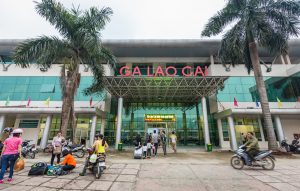Last month, Vietnamese Prime Minister Pham Minh Chinh announced plans to upgrade the railway line connecting Kunming, the capital of China’s Yunnan province to Vietnam’s port at Haiphong on the Gulf of Tonkin, as a part of Beijing’s Belt and Road Initiative (BRI). The statement followed the elevation of the U.S.-Vietnam relationship to a comprehensive strategic partnership and coincided with plans for increased investment, engagement, and cooperation with other U.S.-aligned states in the Indo-Pacific and preceded high-profile diplomatic engagements with China.
On the surface, the proposal appears to stem naturally from Vietnam’s hedging approach to foreign policy; necessarily, the recent friendly interactions with the U.S. and its allies must be accompanied by overtures and deference to China. Given its implications, however, there are signs that this particular project may not be a Vietnamese balancing initiative but rather a coerced response prompted by China.
The railway line in question starts in Kunming, crosses the border at Hekou-Lao Cai, and runs through Vietnam’s capital Hanoi before terminating at the port city of Haiphong. The railway, which was built by the French in the early 20th century, intersects with the newly completed Fanchenggang-Dongxing railway, the first high-speed railway link to Vietnam’s border, which runs from the Guangxi Zhuang Autonomous Region to the existing Vietnamese rail network. Taken on their own, these projects simply represent efforts to enhance connectivity and trade between the two countries. It is notable, however, that the railway runs through Vietnam’s resource-rich heartland and connects to the only transportation lines leading out of Vietnam’s extremely profitable Nui Phao mine.
Despite being significantly smaller in land area than the top producer China, Vietnam has the world’s second-largest reserves of rare-earth metals and the third-largest reserves of tungsten, both of which are vital to the production of technology and armaments. Vietnam’s wealth of resources has attracted the attention of the U.S. and its allies, presenting an alternative to dependency on China. The United States imports up to 74 percent of its rare earth metals and 40 percent of its tungsten from China, and the U.S., Europe, and Japan consume over half of the world’s supply of tungsten, but only producing around 5 percent. It is no surprise that many of Vietnam’s recent engagements with the United States and its allies have involved discussions of industrial investment.
The Nui Phao mine in particular, holds value that cannot be understated. In addition to being one of the world’s largest tungsten mines, with estimated reserves of 66 million metric tons, it is a polymetallic deposit, capable also of yielding significant quantities of fluorspar, copper, and bismuth. Such a mine is rare, and promises profits that could enable Vietnam to rival China’s dominance in the mining sector. Naturally, it would be in China’s favor to coordinate with Vietnam to take advantage of this opportunity, and the proposed railway is a way of China’s government to facilitate these plans.
In general, economic cooperation between Vietnam and China has not yielded the progress that China desires, due to reservations that Vietnam holds towards the BRI. Vietnam is incredibly wary of leverage traps and economic dependence on China, which explains its resistance to joining BRI projects up to this point. Its seeming acceptance of the Kunming-Haiphong railway project as a part of the BRI raises questions as to why Vietnam has departed from its traditional stance towards the Chinese initiative. More intriguing is the fact that when the proposal for this exact project was first unveiled in 2019, Vietnam balked at the initiative, citing a number of economic and security concerns. Vietnam’s Cat Linh-Ha Dong elevated metro rail line in Hanoi is the only project to have received BRI loans and has not been labelled as a part of BRI. Even if Vietnam has had a change of heart, the timing of this announcement is peculiar, layered between important high-level engagements with China, the U.S., and U.S. allies such as Japan.
While Vietnam’s cultivation of multinational partnerships increases its freedom of action, Vietnam’s true level of agency is ultimately dictated by China. China remains the largest economic player in Vietnam and remains capable of punishing Vietnam if Vietnam is unable to reassure China that it is not overstepping the boundaries of autonomy set by China. It was for this reason that Vietnam announced that it was pursuing comprehensive strategic partnerships with Japan, Australia, Indonesia, and Singapore after it elevated the U.S. to that level, seeking to allay China’s fears over Vietnam moving too closely into Washington’s orbit.
Visits to Vietnam by China’s Commerce Minister Wang Wentao and Foreign Minister Wang Yi in recent months have emphasized the importance that China places on developing the Kunming-Haiphong line. President Xi Jinping prioritized the project and cooperation on rare earth metal extraction, even tabling the South China Sea disputes during his historic visit to Vietnam this week, his first to the country since 2017. While agreements on critical minerals and rare earths have been deferred, two memoranda of understanding were signed on cross-border rail development, including aid for such development.
Beijing is ready and willing to offer grants for rail connections, but the volume of aid and terms of any possible loans are still unclear. Currently, Vietnam has limited room to maneuver, having used up all of its autonomy reaching out to the U.S. and its allies. It is now China’s turn to test the limits of Vietnam’s deference.
The views expressed in this article are the author’s own, and do not reflect the official position of the United States Military Academy, Department of the Army, or Department of Defense.

































